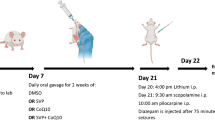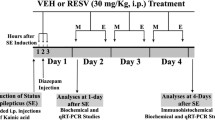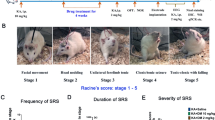Abstract
The initial precipitating injury such as SE progresses to chronic epilepsy through multiple epileptogenic processes. Early epileptogenic events are generally characterized by neuroinflammation, neurodegeneration and abnormal neurogenesis in the hippocampus. Metformin has exhibited anti-inflammatory and neuroprotective properties in numerous studies. The current study attempts to investigate the effect of metformin on seizure-induced inflammation and neuronal degeneration, and the involvement of the mTOR pathway. Status epilepticus (SE) was induced in male Wistar rats with systemic administration of Lithium (127 mg/kg) and Pilocarpine (30 mg/kg). In test rats, Metformin 100 mg/kg or 200 mg/kg was administered orally for 7 days, followed by SE induction. Results indicate that metformin did not alter the SE profile significantly which was evident by the behavioural scoring and electroencephalogram (EEG) recordings. However, metformin 200 mg/kg attenuated the SE-induced glial activation (p < 0.01), up regulated mRNA levels of proinflammatory cytokines (p < 0.001) and chemokines (p < 0.001) and enhanced BBB permeability (p < 0.05). In addition, metformin ameliorated the insult-induced region-specific neuronal damage (p < 0.01) and restored the hippocampal neuronal density. Metformin significantly inhibited phosphorylated S6 ribosomal protein (phospho-S6rp) (p < 0.05), thus demonstrating that the beneficial effects might be partly mediated by the mTOR pathway. The study thus reiterates that mTOR signalling is one of the mechanisms involved in inflammation and neurodegeneration in early epileptogenesis following SE.









Similar content being viewed by others
Abbreviations
- mTOR:
-
Mammalian target of rapamycin
- SE:
-
Status epilepticus
- BBB:
-
Blood–brain barrier
- FJB:
-
Fluorojade B
- Li-Pi:
-
Lithium pilocarpine
References
Alyu F, Dikmen M (2016) Inflammatory aspects of epileptogenesis: contribution of molecular inflammatory mechanisms. Acta Neuropsychiatr 29:1–16
Arbelaez-Quintero I, Palacios M (2017) To use or not to use metformin in cerebral ischemia: a review of the application of metformin in stroke rodents. Stroke Res Treat 2017:9756429
Bankstahl M, Breuer H, Leiter I, Märkel M, Bascuñana P, Michalski D et al (2018) Blood–brain barrier leakage during early epileptogenesis is associated with rapid remodeling of the neurovascular unit. ENEURO 5:0123–0218
Barzilai N, Crandall JP, Kritchevsky SB, Espeland MA (2016) Metformin as a tool to target aging. Cell Metab 23:1060–1065
Chen J, Zheng G, Guo H, Shi ZN, Jiang J, Wang XY et al (2018) The effect of metformin treatment on endoplasmic reticulum stress induced by status epilepticus (SE) via the PERK-eIF2α-CHOP pathway. Bosn J Basic Med Sci 18:49–54
Chi X, Huang C, Li R, Wang W, Wu M, Li J, Zhou D (2017) Inhibition of mTOR pathway by rapamycin decreases P-glycoprotein expression and spontaneous seizures in pharmacoresistant epilepsy. J Mol Neurosci 61:553–562
Cho C, Michailidis V, Martin LJ (2018) Revealing brain mechanisms of mTOR-mediated translational regulation: implications for chronic pain. Neurobiol Pain 4:27–34
Citraro R, Leo A, Constanti A, Russo E, De Sarro G (2016) mTOR pathway inhibition as a new therapeutic strategy in epilepsy and epileptogenesis. Pharmacol Res 107:333–343
Clossen BL, Reddy DS (2017) Novel therapeutic approaches for disease-modification of epileptogenesis for curing epilepsy. Biochim Biophys Acta Mol Basis Dis 1863:1519–1538
Codeluppi S, Svensson CI, Hefferan MP, Valencia F, Silldorff MD, Marsala M et al (2009) The Rheb-mTOR pathway is upregulated in reactive astrocytes of the injured spinal cord. J Neurosci 29:1093–1104
Crino P (2016) The mTOR signalling cascade: paving new roads to cure neurological disease. Nat Rev Neurol 12:379–392
Dello Russo C, Lisi L, Tringali G, Navarra P (2009) Involvement of mTOR kinase in cytokine-dependent microglial activation and cell proliferation. Biochem Pharmacol 78:1242–1251
Dey A, Kang X, Qiu J, Du Y, Jiang J (2016) Anti-Inflammatory small molecules to treat seizures and epilepsy: from bench to bedside. Trends Pharmacol Sci 37:463–484
Drion CM, Borm LE, Kooijman L, Aronica E, Wadman WJ, Hartog AF et al (2016) Effects of rapamycin and curcumin treatment on the development of epilepsy after electrically induced status epilepticus in rats. Epilepsia 57:688–697
Dudek FE (2012) Mechanisms of seizure-induced inflammation of the brain: many possible roles for neuronal COX-2. Epilepsy Curr 12:115–117
El-Mir MY, Detaille D, R-Villanueva G, Delgado-Esteban M, Guigas B, Attia S et al (2008) Neuroprotective role of antidiabetic drug metformin against apoptotic cell death in primary cortical neurons. J Mol Neurosci 34:77–87
Fujikawa DG, Pais ES, Aviles ER, Hsieh KC, Bashir MT (2016) Methamphetamine-induced neuronal necrosis: the role of electrographic seizure discharges. Neurotoxicology 52:84–88
Ge XH, Zhu GJ, Geng DQ, Zhang HZ, He JM, Guo AZ et al (2017) Metformin protects the brain against ischemia/reperfusion injury through PI3K/Akt1/JNK3 signaling pathways in rats. Physiol Behav 170:115–123
Guo D, Zou J, Wong M (2017) Rapamycin attenuates acute seizure-induced astrocyte injury in mice in vivo. Sci Rep 7:2867
Hyun B, Shin S, Lee A, Lee S, Song Y, Ha NJ et al (2013) Metformin down-regulates TNF-α secretion via suppression of scavenger receptors in macrophages. Immune Netw 13:123–132
Jing Y, Wu F, Li D, Yang L, Li Q, Li R (2018) Metformin improves obesity-associated inflammation by altering macrophages polarization. Mol Cell Endocrinol 461:256–264
Kalender A, Selvaraj A, Kim SY, Gulati P, Brûlé S, Viollet B et al (2010) Metformin, independent of AMPK, inhibits mTORC1 in a rag GTPase-dependent manner. Cell Metab 11:390–401
Kelly B, Tannahill GM, Murphy MP, O’Neill LA (2015) Metformin inhibits the production of reactive oxygen species from NADH: Ubiquinone Oxidoreductase to limit induction of Interleukin-1β (IL-1β) and boosts Interleukin-10 (IL-10) in Lipopolysaccharide (LPS)-activated macrophages. J Biol Chem 290:20348–20359
Kickstein E, Krauss S, Thornhill P, Rutschow D, Zeller R, Sharkey J et al (2010) Biguanide metformin acts on tau phosphorylation via mTOR/protein phosphatase 2A (PP2A) signaling. Proc Natl Acad Sci U S A 107:21830–21835
Kim K, Kwak BO, Kwon A, Ha J, Kim SJ, Bae SW (2017) Analysis of plasma multiplex cytokines and increased level of IL-10 and IL-1Ra cytokines in febrile seizures. J Neuroinflamm 14:200
Kim SA, Choi HC (2012) Metformin inhibits inflammatory response via AMPK-PTEN pathway in vascular smooth muscle cells. Biochem Biophys Res Commun 425:866–872
Kumar A, Lalitha S, Mishra J (2013) Possible nitric oxide mechanism in the protective effect of hesperidin against pentylenetetrazole (PTZ)-induced kindling and associated cognitive dysfunction in mice. Epilepsy Behav 29:103–111
Kumar A, Lalitha S, Mishra J (2014) Hesperidin potentiates the neuroprotective effects of diazepam and gabapentin against pentylenetetrazole-induced convulsions in mice: Possible behavioral, biochemical and mitochondrial alterations. Indian journal of pharmacology 46:309–315
Kumari P, Singh N, Saha L (2018) Potentiation of pentylenetetrazole-induced neuronal damage by dimethyl sulfoxide in chemical kindling model in rats. Indian J Pharmacol 50:84–87
Lalitha S, Minz RW, Medhi B (2017) Understanding the controversial drug targets in epilepsy and pharmacoresistant epilepsy. Rev Neurosci 29:333–345
Lashen H (2010) Role of metformin in the management of polycystic ovary syndrome. Ther Adv Endocrinol Metab 1:117–128
Li D, Wang C, Yao Y, Chen L, Liu G, Zhang R et al (2016) mTORC1 pathway disruption ameliorates brain inflammation following stroke via a shift in microglia phenotype from M1 type to M2 type. Faseb 30:3388–3399
Liu J, Wang A, Li L, Huang Y, Xue P, Hao A (2010) Oxidative stress mediates hippocampal neuron death in rats after lithium-pilocarpine-induced status epilepticus. Seizure 19:165–172
Liu Y, Tang G, Li Y, Wang Y, Chen X, Gu X et al (2014) Metformin attenuates blood-brain barrier disruption in mice following middle cerebral artery occlusion. J Neuroinflamm 11:177
Marchi N, Granata T, Freri E, Ciusani E, Ragona F, Puvenna V et al (2011) Efficacy of anti-inflammatory therapy in a model of acute seizures and in a population of pediatric drug resistant epileptics. PLoS ONE 6:e18200
Matsushita M, Kawaguchi M (2018) Immunomodulatory Effects of Drugs for Effective Cancer Immunotherapy. J Oncol 8653489.
Mehan S, Monga V, Rani M, Dudi R, Ghimire K (2018) Neuroprotective effect of solanesol against 3-nitropropionic acid-induced Huntington’s disease-like behavioral, biochemical, and cellular alterations: Restoration of coenzyme-Q10-mediated mitochondrial dysfunction. Indian J Pharmacol 50:309–319
Mehrabi S, Sanadgol N, Barati M, Shahbazi A, Vahabzadeh G, Barzroudi M (2018) Evaluation of metformin effects in the chronic phase of spontaneous seizures in pilocarpine model of temporal lobe epilepsy. Metab Brain Dis 33:107–114
Nakatake R, Iida H, Ishizaki M, Matsui K, Nakamura Y, Kaibori M et al (2018) Metformin inhibits expression of the proinflammatory biomarker inducible nitric oxide synthase in hepatocytes. Funct food health dis 8:175–192
Negrotto L, Farez MF, Correale J (2016) Immunologic Effects of Metformin and Pioglitazone Treatment on Metabolic Syndrome and Multiple Sclerosis. JAMA Neurol 73:520–528
Oliveira WH, Nunes AK, França ME, Santos LA, Lós DB, Rocha SW et al (2016) Effects of metformin on inflammation and short-term memory in streptozotocin-induced diabetic mice. Brain Res 1644:149–160
Peixoto-Santos JE, Velasco TR, Galvis-Alonso O, Araujo D, Kandratavicius L, Assirati JA et al (2015) Temporal lobe epilepsy patients with severe hippocampal neuron loss but normal hippocampal volume: extracellular matrix molecules are important for the maintenance of hippocampal volume. Epilepsia 56:1562–1570
Plata-Salamán CR, Ilyin SE, Turrin NP, Gayle D, Flynn MC, Romanovitch AE et al (2000) Kindling modulates the IL-1beta system, TNF-alpha, TGF-beta1, and neuropeptide mRNAs in specific brain regions. Brain Res Mol Brain Res 75:248–258
Qi B, Hu L, Zhu L, Shang L, Wang X, Liu N et al (2017) Metformin attenuates neurological deficit after intracerebral hemorrhage by inhibiting apoptosis, oxidative stress and neuroinflammation in rats. Neurochem Res 42:2912–2920
Rani L, Minz RW, Sharma A, Anand S, Gupta D, Panda NK et al (2015) Predominance of PR3 specific immune response and skewed TH17 vs. T-regulatory milieu in active granulomatosis with polyangiitis. Cytokine 71:261–267
Rensing N, Han L, Wong M (2015) Intermittent dosing of rapamycin maintains antiepileptogenic effects in a mouse model of tuberous sclerosis complex. Epilepsia 56:1088–1097
Robel S (2016) Astroglial scarring and seizures: a cell biological perspective on epilepsy. Neuroscientist 2016:1073858416645498
Rotermund C, Machetanz G, Fitzgerald JC (2018) The therapeutic potential of metformin in neurodegenerative diseases. Front Endocrinol (Lausanne) 9:400. https://doi.org/10.3389/fendo.2018.00400
Sahan-Firat S, Temiz-Resitoglu M, Guden DS, Kucukkavruk SP, Tunctan B, Sari AN et al (2018) Protection by mTOR inhibition on zymosan-induced systemic inflammatory response and oxidative/nitrosative stress: contribution of mTOR/MEK1/ERK1/2/IKKβ/IκB-α/NF-κB signalling pathway. Inflammation 41:276–298
Saisho Y (2015) Metformin and Inflammation: Its Potential Beyond Glucose-lowering Effect. Endocr Metab Immune Disord Drug Targets 15:196–205
Salem NA, El-Shamarka M, Khadrawy Y, El-Shebiney S (2018) New prospects of mesenchymal stem cells for ameliorating temporal lobe epilepsy. Inflammopharmacology 26:963–972
Saliba SW, Vieira EL, Santos RP, Candelario-Jalil E, Fiebich BL, Vieira LB et al (2017) Neuroprotective effects of intrastriatal injection of rapamycin in a mouse model of excitotoxicity induced by quinolinic acid. J Neuroinflamm 14:25
Shi WY, Xiao D, Wang L, Dong LH, Yan ZX, Shen ZX (2012) Therapeutic metformin/AMPK activation blocked lymphoma cell growth via inhibition of mTOR pathway and induction of autophagy. Cell Death Dis 3:e275
Srivastava IN, Shperdheja J, Baybis M, Ferguson T, Crino PB (2016) mTOR pathway inhibition prevents neuroinflammation and neuronal death in a mouse model of cerebral palsy. Neurobiol Dis 85:144–154
Singh N, Saha L, Kumari P, Singh J, Bhatia A, Banerjee D et al (2019) Effect of dimethyl fumarate on neuroinflammation and apoptosis in pentylenetetrazol kindling model in rats. Brain Res Bull 144:233–245
Takata F, Dohgu S, Matsumoto J, Machida T, Kaneshima S, Matsuo M et al (2013) Metformin induces up-regulation of blood-brain barrier functions by activating AMP-activated protein kinase in rat brain microvascular endothelial cells. Biochem Biophys Res Commun 433:586–590
Tannich F, Tlili A, Pintard C, Chniguir A, Eto B, Dang PM et al (2020) Activation of the phagocyte NADPH oxidase/NOX2 and myeloperoxidase in the mouse brain during pilocarpine-induced temporal lobe epilepsy and inhibition by ketamine. Inflammopharmacology 28:487–497
Ursini F, Russo E, Pellino G, D’Angelo S, Chiaravalloti A, De Sarro G et al (2018) Metformin and autoimmunity: a “new deal” of an old drug. Front Immunol 9:1236
van Vliet EA, da Costa AS, Redeker S, van Schaik R, Aronica E, Gorter JA (2007) Blood-brain barrier leakage may lead to progression of temporal lobe epilepsy. Brain 130:521–534
van Vliet EA, Forte G, Holtman L, Den Burger JC, Sinjewel A, De Vries HE et al (2012) Inhibition of mammalian target of rapamycin reduces epileptogenesis and blood–brain barrier leakage but not microglia activation. Epilepsia 53:1254–1263
Vezzani A, Friedman A, Dingledine RJ (2013) The role of inflammation in epileptogenesis. Neuropharmacology 69:16–24
Vezzani A, Dingledine R, Rossetti AO (2015) Immunity and inflammation in status epilepticus and its sequelae: possibilities for therapeutic application. Expert Rev Neurother 15:1081–1092
Vezzani A, Lang B, Aronica E (2016) Immunity and inflammation in epilepsy. Cold Spring Harb Perspect Med 6:a022699
Wang FX, Xiong XY, Zhong Q, Meng ZY, Yang H, Yang QW (2017) Foxp3 exhibits antiepileptic effects in ictogenesis involved in TLR4 signaling. FASEB J 31:2948–2962
Wang SJ, Bo QY, Zhao XH, Yang X, Chi ZF, Liu XW (2013) Resveratrol pre-treatment reduces early inflammatory responses induced by status epilepticus via mTOR signaling. Brain Res 1492:122–129
Wang C, Wang Q, Lou Y, Xu J, Feng Z, Chen Y et al (2018) Salidroside attenuates neuroinflammation and improves functional recovery after spinal cord injury through microglia polarization regulation. J Cell Mol Med 22:1148–1166
Wetherington J, Serrano G, Dingledine R (2008) Astrocytes in the epileptic brain. Neuron 58:168–178
Xie L, Sun F, Wang J, Mao X, Xie L, Yang SH et al (2014) mTOR signaling inhibition modulates macrophage/microglia-mediated neuroinflammation and secondary injury via regulatory T cells after focal ischemia. J Immunol 192:6009–6019
Ye X, Zhu M, Che X, Wang H, Liang XJ, Wu C (2020) Lipopolysaccharide induces neuroinflammation in microglia by activating the mTOR pathway and downregulating Vps34 to inhibit autophagosome formation. J Neuroinflamm 17:18
Yang MT, Lin YC, Ho WH, Liu CL, Lee WT (2017) Everolimus is better than rapamycin in attenuating neuroinflammation in kainic acid-induced seizures. J Neuroinflamm 14:15
Youn Y, Sung IK, Lee IG (2013) The role of cytokines in seizures: interleukin (IL)-1β, IL-1Ra, IL-8, and IL-10. Korean J Pediat 56:271–274
Zeng LH, Rensing NR, Wong M (2009) The mammalian target of rapamycin signaling pathway mediates epileptogenesis in a model of temporal lobe epilepsy. J Neurosci 29:6964–6972
Zhao RR, Xu XC, Xu F, Zhang WL, Zhang WL, Liu LM et al (2014) Metformin protects against seizures, learning and memory impairments and oxidative damage induced by pentylenetetrazole-induced kindling in mice. Biochem Biophys Res Commun 448:414–417
Zhong LM, Zong Y, Sun L, Guo JZ, Zhang W, He YD (2012) Resveratrol inhibits inflammatory responses via the mammalian target of rapamycin signaling pathway in cultured LPS-stimulated microglial cells. PLoS ONE 7:e32195
Zhu X, Liu J, Chen O, Xue J, Huang S, Zhu W et al (2019) Neuroprotective and anti-inflammatory effects of isoliquiritigenin in kainic acid-induced epileptic rats via the TLR4/MYD88 signaling pathway. Inflammopharmacology 27:1143–1153. https://doi.org/10.1007/s10787-019-00592-7
Zi F, Zi H, Li Y, He J, Shi Q, Cai Z (2018) Metformin and cancer: An existing drug for cancer prevention and therapy. Oncol Lett 15:683–690
Acknowledgements
This work was supported by the Department of Biotechnology (DBT), India. Research fellowship was provided by the Council of Scientific & Industrial Research (CSIR), India.
Author information
Authors and Affiliations
Corresponding author
Ethics declarations
Competing interest
No competing interest.
Additional information
Publisher's Note
Springer Nature remains neutral with regard to jurisdictional claims in published maps and institutional affiliations.
Rights and permissions
About this article
Cite this article
Bojja, S.L., Medhi, B., Anand, S. et al. Metformin ameliorates the status epilepticus- induced hippocampal pathology through possible mTOR modulation. Inflammopharmacol 29, 137–151 (2021). https://doi.org/10.1007/s10787-020-00782-8
Received:
Accepted:
Published:
Issue Date:
DOI: https://doi.org/10.1007/s10787-020-00782-8




